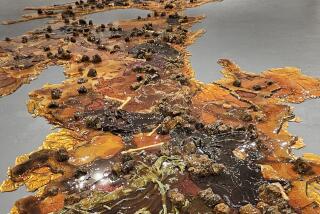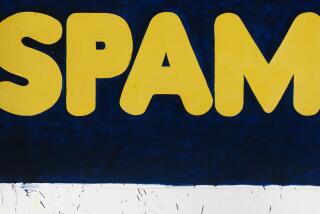On road to recovery, Todd Marinovich discovers painting
- Share via
Todd Marinovich craned his sinewy neck and looked up, way up, at the expansive wall.
“On top there, that’s the more perfect, traditional part of this mural,” he said, tugging at his brown baseball cap as he focused on the scraggly, spray-painted tree, its roots diving into deep soil.
He motioned toward the two-story wall’s base, where the imagery was more abstract: a serpent, a fish, a flower — unkempt and playful, green and blue and black.
“I like this part the best,” he said. “You don’t want art that’s just all neat and tidy. It’s animalistic and unpredictable and messy. You can’t put it into a safe box.”
Marinovich, 45, could have been describing himself.
His story has been well-chronicled: The Cliff Notes version is a dream shattered by pressure and despair.
He grew up famous, an Orange County favorite son dubbed the “Robo quarterback” in high school by national media — which focused as much on his football skills as on the intense training regime his father, Marv, had pushed him through since infancy.
He won a Rose Bowl for USC. He started for the Raiders when they made their home in Los Angeles. But he also unraveled in full public view. Marinovich became a hard-core drug addict. He lost his career, and nearly his life, in a haze of pot, cocaine and heroin.
The last image many have is of him standing before a judge after yet another arrest.
But life for Todd Marinovich has changed once again. “I’m evolving,” he said, a smile on his narrow face.
About five years ago, Marinovich began making a living off his artwork — his paintings and sculptures have been featured in galleries. His latest job is the biggest payday yet: a $20,000 mural project commissioned by the city of Garden Grove. His canvas is a wide exterior wall outside the historic Gem Theater, smack in the heart of a suburb lost in the shadow of nearby Disneyland.
“There’s a parallel,” said Steve Jones, the city councilman who reached out to Marinovich four months ago, asking if the former quarterback could do the job. “He’s trying to overcome stigma, he’s reinvented himself as an artist. We’re trying to overcome a stigma too, that image of a flat city in Orange County that’s sort of forgotten. Some people call us ‘Garbage Grove.’”
“Me and the city have certain reputations, it’s true, but I want to go beyond that, I want this to be about the art,” said Marinovich, recognizable even though his trademark red locks have been shorn and his skin leathered by the sun and hard living. “This piece, this piece just feels so right. First time I heard about it, I knew I was the right one for the job — it’s one of the biggest things I’ve ever done.”
For nearly a month, he was cordoned behind a tarp-covered chain-link fence, standing in the square carriage of an electric lift that can raise him 30 feet high. Sometimes people stopped by, word having leaked that Marinovich was in town, making art of all things. Sometimes he worked for hours without a bother — mornings, afternoons and late at night, under the glare of floodlights.
The mural, striped, dappled and meant to evoke the city’s rural past, was unveiled for Sunday’s Re: Imagine Garden Grove festival.
Marinovich has a humble charm. There are no airs about him, not with his past.
In the languid but weary cadence of a surfer who has seen the worst parts of life, he spoke on a recent afternoon of how he had to beat back fear and doubt before starting the mural. How he leaned on the fact he’s done a fair amount of graffiti work before — “most of it without what you’d call a ‘proper credential,’” he said.
He mused, too, about the toll drugs and football-related concussions have taken on his memory. There are large chunks of the past that he just can’t recall. Names, even of close friends, can evade him at inopportune moments. He’s lost his wallet three times in the last two weeks. It’s typical, and frightening.
“If I make it to my 70s,” he said, “I will be surprised.”
What keeps him going is family.
“I need them because I am very impulsive and sometimes I don’t make the best decision. Without them, who knows, all bets are off …,” His voice trailed. He was thinking about his dad, worried because his father’s health hasn’t been the best of late.
All those old stories about Marv, which is what Marinovich calls his father, the ones characterizing him as the football-crazed mad scientist who drove his son to the brink? Too easy, too pat, too simple, Marinovich said, holding a can of spray paint. “The reality was way more complicated … but the media didn’t get that. Sure, I was pushed, but I loved a lot of it. And I loved my father and always will.”
Marinovich has a wife now, Alix, whom he met in drug court. They have two young children: a 3-year-old girl, Coski, and a 5-year-old boy, Baron, who Marinovich said will never be allowed to play football because of the concussion risk.
Two years ago they moved from Newport Beach to a small town in central Oregon. While there Marinovich was paid to create his first official mural: an electric pink sunset illuminating a horse corral. Other than a stint playing professionally in Canada — a desperate period when his heroin addiction was in full bloom — it was the first time he’d ever put down roots outside Southern California.
But the allure of home proved too much. In May, the family moved back, settling in a little cottage in Oceanside. Paying the bills is always a struggle, but Marinovich hopes the Garden Grove mural will give his art career a boost.
Early on in the project, he invited local schoolkids to help. They took spray paint to the wall, scrawling free-form figures wherever they could. When the kids had finished, someone wondered whether their work shouldn’t be painted over. “Not a chance,” Marinovich said, vowing to turn it into the mural’s foundation.
Then there are the scraggly tree and its roots.
“I’m going to turn those into people,” he said, zooming toward the mural’s top on his lift. “How? I don’t know. It’s a messy process. There’s an element of giving up control and that’s really important.... You see one thing on the surface, but you don’t know what you’re going to get.”
Twitter: @kurtstreeter
More to Read
Sign up for Essential California
The most important California stories and recommendations in your inbox every morning.
You may occasionally receive promotional content from the Los Angeles Times.











